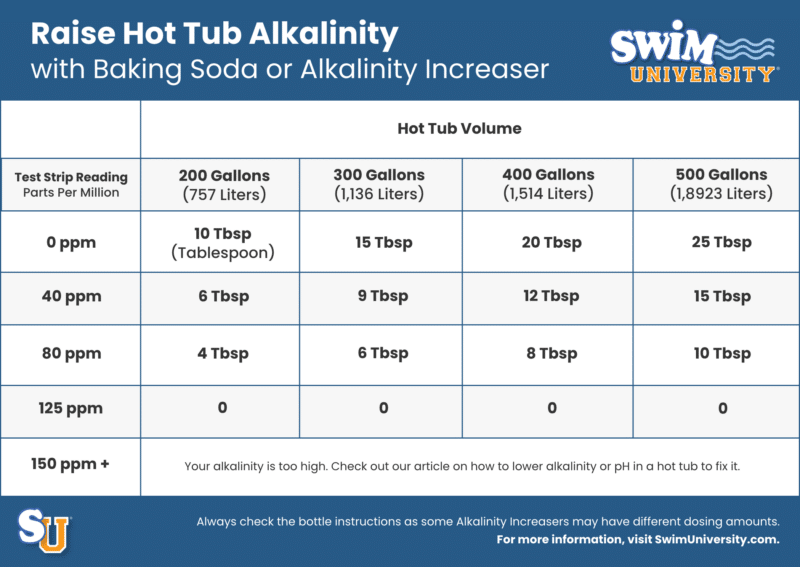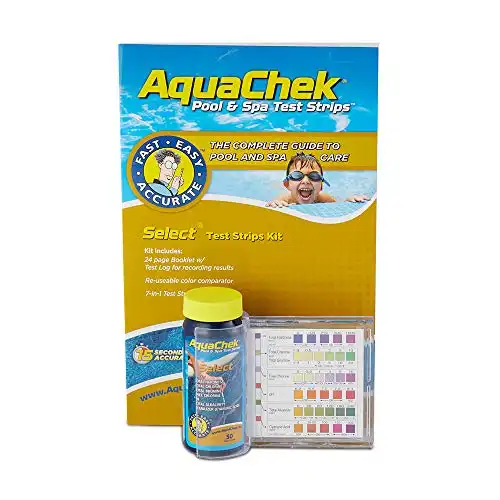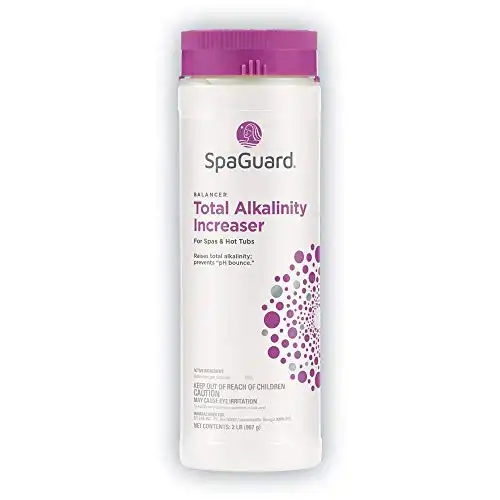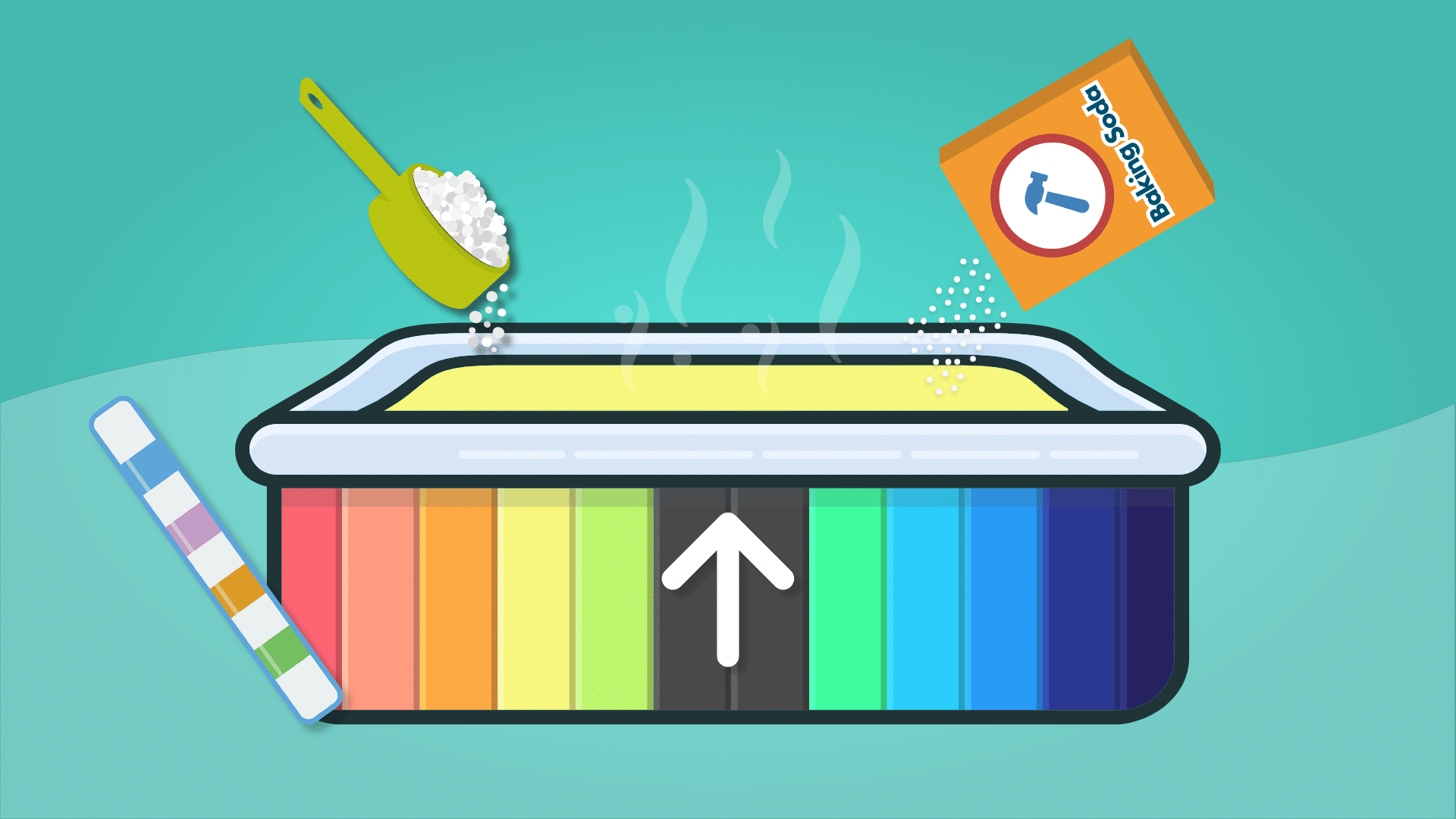How to Raise Alkalinity in a Hot Tub
The easiest way to raise the total alkalinity level in your hot tub or swim spa is to use an Alkalinity Increaser. You can also use baking soda to raise alkalinity. Use the chart below to determine the amount you need based on your current reading.
Is Baking Soda and Alkalinity Increaser The Same Thing?
Yes. Baking soda can be used as an alkalinity increaser in pools and hot tubs. The main ingredient is Sodium Bicarbonate. But make sure the baking soda you use doesn’t have any additional additives. Use 1 tablespoon (17 grams) of baking soda per 100 gallons (379 liters) of water to raise alkalinity by 10 ppm (parts per million).
Now that you know how, let’s find out why you even need it.
My fool-proof system for keeping any hot tub clean and clear at all times. Our course covers every type of hot tub, including portable spas, inflatable hot tubs, inground hot tubs, swim spas, and more. This is the LAST and ONLY hot tub guide you'll need.
What is Alkalinity and Why is it Important?
You must balance your hot tub’s pH level (acidity) so that it feels good on your skin and allows your sanitizer or disinfectants (like chlorine or bromine) to be effective at killing bacteria.
If you have low pH (and alkalinity), it can cause corrosion of metal parts in your hot tub and skin irritation. On the other hand, if you have have high pH (and high alkalinity), it can cause cloudy water, calcium build-up, and skin irritation, too.
The pH (potential of hydrogen) is the primary measurement of how acidic or basic your water is. It’s on a scale from 0 to 14, with 7 being perfectly balanced. If the pH reading is closer to 0, that means your water is acidic (think battery acid). If it’s close to 14, it’s basic (think drain cleaner). The perfect pH is 7, which is what human tears are. Here’s our pH scale to help you understand.

In a hot tub, your pH reading should be more basic. The ideal range is between 7.4 and 7.6. But what about alkalinity?
Alkalinity is a pH buffer. I like to think of it as pH’s bodyguard. Without alkalinity in your water, it would cause wild pH fluctuations, and impossible to keep your pH stable. But why?
Everything affects the pH. When you soak in the water, the pH could go up or down. The same goes for if you add chemicals, turn on the jets, and leaving the cover off while it rains or snows.
We raise the alkalinity in a hot tub to protect the pH level from bouncing all over the place. The alkalinity takes the hit, so your pH remains stable.
What’s The Ideal Range for Alkalinity in a Hot Tub?
You need to keep the total alkalinity reading in your hot tub between 100 and 150 ppm (parts per million). You can keep it as low as 80 ppm, but not any lower.
How to Test Hot Tub Alkalinity
To test the spa water, you need either test strips or a liquid test kit. I prefer test strips because they’re quick and easy to use. Here’s the one I recommend.
Tests for 7 important chemistries in seconds: Total Hardness, Total Chlorine, Total Bromine, Free Chlorine, pH, Total Alkalinity, and Cyanuric Acid.
But they’re less accurate than a liquid test kit. So, if you’re a perfectionist, go with a liquid test kit with a digital reader.
NOTE: Before you can test your hot tub’s pH level and alkalinity, you need to know how many gallons of water it holds (or liters). If you need help, here’s our article on how to find out how many gallons your hot tub holds.
- With dry hands, remove one test strip from the bottle and dip it in the center of the hot tub (or as close as possible). Or better yet, grab a water sample in a clean plastic bottle and let it come to room temperature.
- Shake off any excess water and wait about 15 seconds.
- Match up the colors on the test strip to the back of the bottle as close as you can. That’s your readings!
If you’re colorblind, you need to get someone else to read the strips for you. You’ll also need help with a liquid test kit. You can use a test strip reader app or a liquid test kit with a digital reader.
Here’s a Step-by-Step Guide to Raising Alkalinity (and pH) in a Hot Tub
Whether you just filled your hot tub with fresh water or just enjoyed a long soak, the same process applies. And I’m assuming your alkalinity levels are low. Check out our guide on how to lower alkalinity in a hot tub here.
- Test the water to determine the current pH and alkalinity levels.
- Turn the hot tub jets on low and turn off the air valves.
- Add the correct amount of Alkalinity Increaser or baking soda based on your current reading (using the chart below).
- Wait 5 to 15 minutes to let the chemical mix into the water. Leave the cover off during this time.
- Retest the water to see if you reached the ideal alkalinity range. If not, repeat these steps. NOTE: increasing alkalinity will also increase the pH reading.

A Quick Word About Chemical Safety
I recommend using chemical-resistant gloves and goggles when adding hot tub chemicals. Alkalinity Increaser and baking soda can irritate your eyes and skin.
Increase your hot tub total alkalinity with alkalinity increaser. Low alkalinity affects your pH and can stain and damage your hot tub surfaces and equipment.
Hot Tub Maintenance Tips to Keep Alkalinity Balanced
Maintaining consistent alkalinity levels in your hot tub is crucial for water balance and the longevity of your spa. Here are some tips and best practices:
- Regular Testing: Check your hot tub’s alkalinity levels at least once a week using reliable test strips or a digital tester. Consistent monitoring helps in making timely adjustments.
- Proper Water Circulation: Ensure your hot tub’s filter system is functioning efficiently. Regular circulation helps distribute chemicals evenly, maintaining a balanced water chemistry.
- Clean Filters Regularly: Clean and replace hot tub filters as recommended by the manufacturer. Dirty filters can lead to poor water quality and imbalanced alkalinity.
- Control Hot Tub Usage: Heavy usage can deplete chemicals and alter water balance. After a lot of use, retest and adjust the water chemistry as needed.
- Use Fresh Water: Change your hot tub water every 3 to 4 months. Over time, water can absorb many chemicals and become difficult to balance.
- Follow a Water Care Maintenance Schedule: Keep a regular maintenance schedule for cleaning, testing, and adjusting your hot tub water. Consistency is key to maintaining water balance. Download our cheat sheet.
Frequently Asked Questions About Raising Alkalinity in a Hot Tub
I sent an email to 15,000 hot tub owners and asked for any questions about balancing alkalinity and water pH. And I’ve got the answers!
How do I fix low total alkalinity in my hot tub?
Add an Alkalinity Increaser or Baking Soda (sodium bicarbonate) following the manufacturer’s instructions for the right amount.
Can you raise alkalinity in a hot tub without raising pH?
No. When you raise the total alkalinity level with a Total Alkalinity Increaser or baking soda, it’ll also raise the pH slightly. If your pH is too high, I recommend checking out our guide on lowering hot tub pH.
Can you use a hot tub if alkalinity is high?
It’s best to avoid using the hot tub if the alkalinity is too high. Going into a hot tub with low alkalinity can be uncomfortable and might cause skin and eye irritation. You can lower the total alkalinity reading by using pH Decreaser. Warning: do not use muriatic acid to lower alkalinity in a hot tub.
Should you adjust pH or alkalinity first in a hot tub?
Adjust alkalinity first, as this can often help stabilize pH levels, making it easier to balance your hot tub’s water chemistry.
Will shocking a hot tub lower alkalinity?
No. Shocking can actually raise the alkalinity (and pH) level of hot tub water if it contains chlorine. Non-chlorine shocks have less impact. We recommend shocking with non-chlorine shock for regular maintenance. Check out our complete guide on shocking a hot tub.
How long does it take for baking soda to raise alkalinity in a hot tub?
Baking soda can start raising alkalinity in a hot tub within a few minutes. Still, it’s best to retest the water after 15 minutes for accurate results.
How do you lower alkalinity in a hot tub?
The best way to lower alkalinity (and lower pH) is to use a
Will pH Increaser also increase hot tub alkalinity?
It will have no (or very little) effect on your total alkalinity reading. The main ingredient in pH increaser is sodium carbonate (which is very close to sodium bicarbonate). However, it’s not the chemical itself that won’t raise the alkalinity; it’s the amount. You only need a small amount of pH increaser to raise the pH. Check our article on raising hot tub pH for more information.
3 More Ways We Can Help With Your Hot Tub
- Hot Tub Cheat Sheets (Free): Easy-to-use guides to help you keep your hot tub water balanced and sanitized.
- The Hot Tub Handbook: An illustrated guide to DIY hot tub care, including water chemistry, maintenance, troubleshooting, and more.
- The Hot Tub Care Course. You’ll get step-by-step videos and a step-by-step downloadable guide with everything you need to know about hot tub maintenance.











